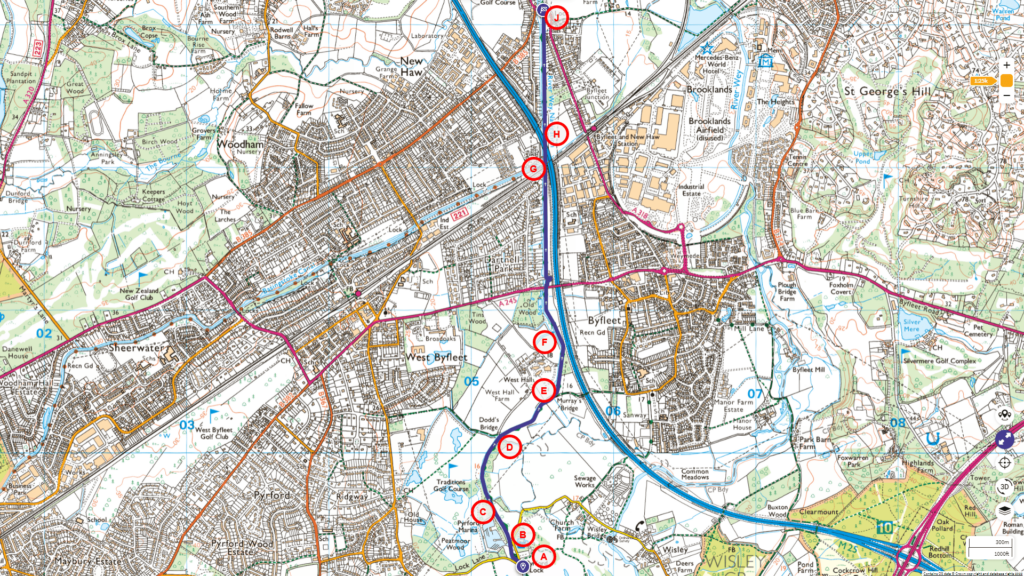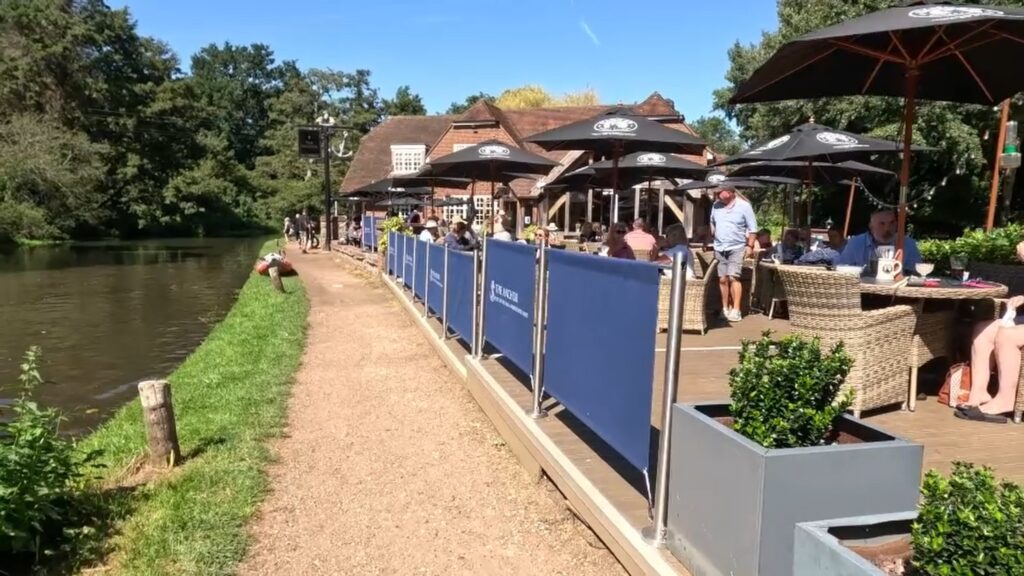Come along for a leisurely walk along the scenic River Wey, passing by charming pubs and a marina, until you reach the outskirts of Greater London.
Follow the entire walk on Link to . The route map is available on
.

B:Anchor Pub
C:Pyford Marina
D:Dobbs Bridge
E:Murray’s Bridge
F:West Hall Nursing Home (Noise of M25)
G:Basingstoke Canal
H:Under the M25
J:New Haw Lock
The walk begins at the historic Pyrford Lock, nestled in the heart of Surrey on the River Wey. This picturesque lock, managed by National Trust, is a serene starting point for our journey. As you take your first steps, you might spot the Mary Elizabeth boat, a common sight here.
Adjacent to the lock is a short bridge, a vital artery connecting the local community. It’s not uncommon to see cars meandering their way across this quaint structure, adding a hint of charm to the rural landscape.
Our next stop is The Anchor Country Pub & Restaurant. The journey to this riverside establishment should take around 15-20 minutes by foot, covering a distance of approximately 0.8 miles.
Upon reaching The Anchor, the atmosphere shifts from serene to lively. Families gather here, their children playing freely in the open space while others prepare for water sports. Kayaks and surfboards are a common sight. Meanwhile, cyclists traverse the path alongside the river, adding a dynamic element to the scene.
The Anchor serves as a hub for outdoor activities in the area. Its location right on the River Wey makes it a popular stop for those enjoying the waterway. Whether you’re here to relax with a meal or to embark on a kayaking adventure, The Anchor offers something for everyone. It’s an integral part of the community, bringing together locals and visitors alike in shared enjoyment of the beautiful riverside setting.
Leaving behind the lively atmosphere of The Anchor Country Pub & Restaurant, we continue our journey along the River Wey towards Pyrford Marina. Situated just a short walk away, this location is a haven of tranquility amidst the Surrey countryside.
The marina is flanked by tall trees and shrubs, creating a natural sanctuary for local wildlife and offering shade for those walking along the towpath. As you stroll, you’ll notice a few kayakers gently navigating the calm waters, contributing to the serene ambiance of the area.
Pyrford Marina serves as a convenient stopover for boaters and is also a popular spot among local birdwatchers. The surrounding greenery is home to various bird species, making it an ideal location for those looking to connect with nature.
From Pyrford Marina, it’s a 15-minute walk to Dodd’s Bridge. This part of the journey offers a shaded path, providing relief from the sun and adding to the comfort of your walk.
Named after local landowner Dodd Harris, the bridge was originally known as Harris’ Bridge in 1823, providing an entrance to nearby West Hall.
Dodd’s Bridge marks not just a physical crossing over the River Wey but also a transition from the liveliness of the marina to the quiet charm of the countryside. It’s a perfect spot to pause, take in the scenery, and prepare for the next segment of the journey towards Murray’s Bridge and West Hall.
As we leave behind Dodd’s Bridge, we continue our journey along the River Wey towards Murray’s Bridge. This charming bridge was originally known as Twigs Bridge in 1823 and was built to provide a convenient passage over the canal from West Hall to Byfleet village.
The walk to Murray’s Bridge retains the tranquil atmosphere of the previous sections, with the shaded towpath offering a cool respite from the sun. The surrounding tall trees and shrubs continue to frame the river beautifully, creating an idyllic backdrop for our journey.
Upon reaching Murray’s Bridge, you’ll be struck by its rustic charm. It serves as a poignant reminder of the area’s history, standing as a testament to the past while still serving a vital role in the present-day navigation of the River Wey.
As you cross Murray’s Bridge, take a moment to absorb the peaceful surroundings.
Stepping away from the Basingstoke Canal Junction, you will find yourself on a path that circles around Parvis Wharf. This area, steeped in history, was once a hub of activity for loading and unloading goods. Today, it’s a place of quiet reflection where one can appreciate the River Wey’s contribution to local commerce.
A small walkway on the right side of Parvis Wharf takes you to Old Parvis Road. This route, though less traveled, offers a unique perspective of the surrounding countryside and the chance to spot local wildlife.
Upon reaching the end of the narrow walkway, turn left and then right to reach the Byfleet Boat Club. A hive of activity, this club is a beloved community spot known for its boating events and regattas.
As you continue your journey straight from the boat club, you’ll pass by Dartnell Park on the left side of the river. This park, with its stunning riverfront homes, offers a glimpse into the daily life of the locals. The path from the club to the railway bridge is shaded by tall trees, providing a respite from the summer sun.
Passing under the railway bridge, you’ll soon spot the Basingstoke Canal Junction on your left.
This junction has a significant place in English history, having been completed in 1794 as a means of connecting Basingstoke with the River Thames at Weybridge via the Wey Navigation. The canal played a key role in the development of agriculture in central Hampshire.
Just beyond the junction, you’ll spot the London Orbital Motorway (M25) looming above you. This sight marks the intersection of historical waterways and modern infrastructure, signifying the evolution of transportation methods over centuries.
Don’t be surprised to see a shift in the scenery as you walk underneath the M25. The shady, tree-lined towpath will give way to a more urban landscape, but not for long. As you continue your journey, you’ll soon be back on the familiar towpath, lined with trees and boats moored near the river bank on the left side.
The area becomes more bustling as you approach New Haw Lock, with increased foot traffic and boating activity. Just before reaching the lock, you’ll notice a car park area on your right. And then, the lock keeper’s cottage on your left will signal that you’ve arrived at New Haw Lock.
New Haw Lock’s enduring presence stands as a testament to the historical significance of this waterway. Originally constructed in the 1650s, it played a crucial role in facilitating trade and transport.
The lock is surrounded by an air of vibrancy, with its lively atmosphere and the delightful sight of boats bobbing gently on the water. The lockkeeper’s cottage, a charming structure nestled on the left, adds a touch of quaintness to the scene.
On sunny days, the lock area transforms into a canvas painted with shimmering reflections of the surrounding scenery on the water’s surface, creating a mesmerizing spectacle. The lush greenery, the rhythm of the flowing water, and the architectural charm of the lock itself all contribute to the captivating beauty of New Haw Lock, a fitting finale to our journey.
We end our journey here for now. We can’t wait to share another stroll with you soon.

